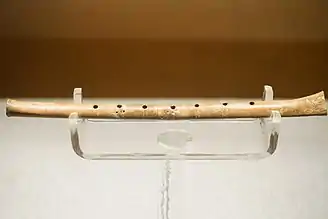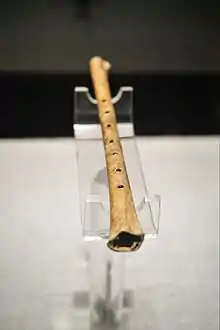Gudi (instrument)
The Jiahu gǔdí (Chinese: 贾湖骨笛) are the oldest known musical instruments from China, dating back to around 6000 BCE. Gudi means "bone flute" in Chinese.

History
Since 1984, six complete bone flutes, as well as the fragments of at least thirty more,[1] have been excavated from several early Neolithic Jiahu culture tombs in Jiahu, Wuyan County, Henan Province, in Central China.[2] They have been dated to 6000 BCE.[3]
Description
The bone flutes have average dimensions of approximately 20 cm × 1.1 cm (7.9 in × 0.4 in), and are made from the legs of the red-crowned crane.[4][5] They are open-ended and vary in the number of their finger holes, from one to eight; the 24 holed version has 23 holes in front and one thumb hole in back. Jiahu bone whistles are much shorter than the flutes, with lengths of 5.7 to 10.5 cm (2 to 4 in), and having only a couple of holes. The number of holes and the spacing between the holes determined the musical range and scale or mode in which the flute was intended to function. Lee and Shen believed that the Jiahu culture understood the "resonance of an air column" (see open tube and closed tube) and were able to create an instrument that contained their "complete interval preference of Chinese music". Blowing across the open end of an end-blown bone flute to produce a musical sound, is accomplished in the same way, and produces a similar effect, as blowing across the open top of a bottle. The eight-holed flute can play "all harmonic intervals and two registers." These harmonic intervals are said to be a "function of culture" and were of a larger set compared to that now familiar in the West. Bone flutes were apparently also played as part of sacrificial rites, and employed in bird hunting. Gudi are not very common now, but there are some musicians today who play them.
Gallery
See also
References
- Zhang, Juzhong; Harbottle, Garman; Wang, Changsui; Kong, Zhaochen (1999-09-23). "Oldest playable musical instruments found at Jiahu early Neolithic site in China". Nature. 401 (6751): 366–368. doi:10.1038/43865. ISSN 1476-4687. PMID 16862110.
- Henan Provincial Institute of Cultural Relics, 河南省文化研究所 (January 1989). "河南舞阳贾湖新石器时代遗址第二至六次发掘简报(in Chinese)". Wenwu 文物 (1): 1–14,47. Retrieved 25 July 2021.
- Picard, François (28 May 2015) [8 December 2014]. "Gudi". Grove Music Online. Oxford: Oxford University Press. doi:10.1093/gmo/9781561592630.article.L2281191. ISBN 978-1-56159-263-0. (subscription or UK public library membership required)
- Henan Provincial Institute of Cultural Relics (January 1989). "河南舞阳贾湖新石器时代遗址第二至六次发掘简报(in Chinese)". Wenwu 文物 (1): 12. Retrieved 25 July 2021.
- Huo, Kun (July 2017). "贾湖骨笛乐音初义(in Chinese)". 北方音乐 North Music. 37 (7): 27–28. Retrieved 25 July 2021.
Sources
- Chang, Lulu Huang. From Confucius to Kublai Khan. Canada: The Institute of Mediaeval Music, 1993. (2-7)
- Lee, Yuan-Yuan and Sin-Yan Shen. Chinese Musical Instruments. Chicago: Chinese Music Society of North America, 1999. (63-66)
- Shen, Sin-Yan. China: A Journey into Its Musical Art. Chicago: Chinese Music Society of North America, 2000. (107-108)
- So, Jenny F. ed. Music in the Age of Confucius. Washington, D.C.: Freer Gallery of Art and Arthur M Sackler Gallery, 2000. (88-90)
- Wu, Ben. "Archaeology and History of Musical Instruments in China". The Garland Encyclopedia of World Music East Asia: China, Japan, and Korea. Vol. 7. Ed Robert C. Provine, Yosihiko Tokumaru, and J Laurence Witzleban. New York: Routledge, 2002. (105-6)
- Zhang, Juzhong; Harbottle, Garman; Wang, Changsui; Kong, Zhaochen (September 1999). "Oldest playable musical instruments found at Jiahu early Neolithic site in China". Nature. 401 (6751): 366–368. Bibcode:1999Natur.401..366Z. doi:10.1038/43865. PMID 16862110.
Further reading
- Huang, Xiang-peng (黄翔鹏) (1989). "Wuyang Jiahu gudi de ceyin yanjiu (舞阳贾湖骨笛的测音研究) " [Pitch Measurement Studies of Bone Flutes from Jiahu of Wuyang County]. Wenwu (文物) [Cultural Relics], no. 1:15–17. Reprinted in 黄翔鹏文存 [Collected Essays of Huang Xiang-Peng], 2 vols, edited by Zhongguo Yishu Yanjiuyuan Yinyue Yanjiusuo (中国艺术研究院音乐研究所), 557–60. Ji'nan, China: Shandong Wenyi Chubanshe, 2007. ISBN 978-7-5329-2669-5.
- Wu, Zhao (吴钊) (1991). "Jiahu guiling gudi yu Zhongguo yinyue wenming zhi yuan (贾湖龟铃骨笛与中国音乐文明之源)" [The relation of Jiahu bone flutes and turtle shell shakers to the origin of Chinese music]. Wenwu (文物) [Cultural Relics], no. 3: 50–55.
External links
- Flutes under Wind Section
- Musical Description at the Wayback Machine (archived October 27, 2009)
- Natural History Magazine


